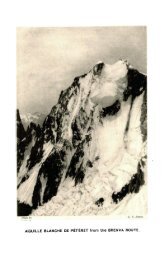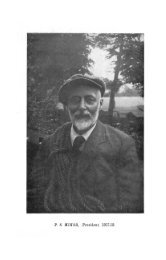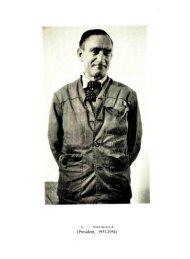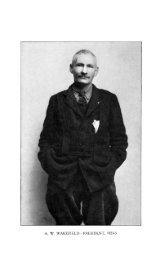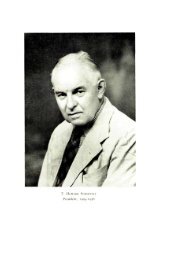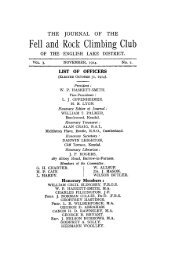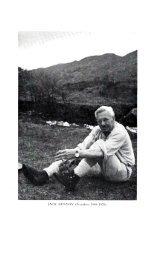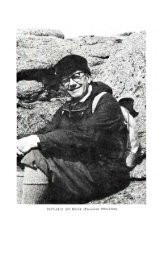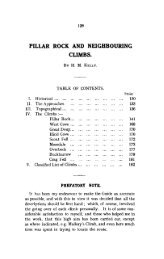Number in series 70; Year of publication 1986 - Fell and Rock ...
Number in series 70; Year of publication 1986 - Fell and Rock ...
Number in series 70; Year of publication 1986 - Fell and Rock ...
Create successful ePaper yourself
Turn your PDF publications into a flip-book with our unique Google optimized e-Paper software.
John Wilk<strong>in</strong>son 6 5be<strong>in</strong>g made by the older clubs, which were now hav<strong>in</strong>g great difficulty <strong>in</strong>recruit<strong>in</strong>g young active climbers. Prom<strong>in</strong>ent amongst the clubs formed at thattime was the <strong>Rock</strong> <strong>and</strong> Ice Club whose members, particularly Joe Brown <strong>and</strong>Don Whillans, made a last<strong>in</strong>g <strong>and</strong> outst<strong>and</strong><strong>in</strong>g contribution to the development<strong>of</strong> the sport <strong>of</strong> rock climb<strong>in</strong>g, <strong>and</strong> pushed up st<strong>and</strong>ards to heights previouslyunatta<strong>in</strong>ed.The great explosion <strong>of</strong> st<strong>and</strong>ards <strong>in</strong> the 1950's was due not only to the largernumber <strong>of</strong> climbers, but more significantly to the <strong>in</strong>troduction <strong>of</strong> new climb<strong>in</strong>gtechniques <strong>and</strong> equipment, which resulted <strong>in</strong> vastly improved safety measures.Nylon ropes, which dur<strong>in</strong>g the war had been used for tow<strong>in</strong>g gliders, now beganto make their appearance on the crags; they were much stronger than themanilla ropes used earlier <strong>and</strong>, more importantly, they stretched <strong>in</strong>stead <strong>of</strong>snapp<strong>in</strong>g. Runn<strong>in</strong>g belays were now used whenever possible, <strong>and</strong> manufacturedwhere necessary, us<strong>in</strong>g first knotted sl<strong>in</strong>gs, <strong>and</strong> later artificial chockstones<strong>in</strong>serted <strong>in</strong>to cracks. (Joe Brown used to carry a selection <strong>of</strong> small stones tucked<strong>in</strong>to his balaclava). Greater protection meant that climbers were now able topush themselves further without the risk <strong>of</strong> a catastrophic fall. Forgotten wasthe unwritten law that the leader must never fall, <strong>and</strong> many leaders now beganto press themselves to the limit <strong>and</strong> even beyond it. There is no doubt that the<strong>in</strong>creased use <strong>of</strong> protection <strong>in</strong> the post-war years has substantially reduced thedeath rate from climb<strong>in</strong>g accidents (<strong>Fell</strong> <strong>and</strong> <strong>Rock</strong> Journal 1981, pp 135-148).One effect <strong>of</strong> the improved protection was the phas<strong>in</strong>g-out <strong>of</strong> top rop<strong>in</strong>g <strong>of</strong> newclimbs practised by some leaders, although it did encourage others to be over<strong>in</strong>dulgent<strong>in</strong> the use <strong>of</strong> pitons <strong>and</strong> sl<strong>in</strong>gs on chockstones for aid. This wasparticularly noticeable <strong>in</strong> Borrowdale, where Ross <strong>and</strong> his contemporariesattacked many impos<strong>in</strong>g l<strong>in</strong>es previously regarded as unclimbable. They refusedto be thwarted by technical difficulty, <strong>and</strong> if a climb did not yield, aid was usedwithout qualm. This practice encouraged others, <strong>and</strong> the excessive use <strong>of</strong> aidwas dest<strong>in</strong>ed to cont<strong>in</strong>ue for a number <strong>of</strong> years all over the District, despite thelead given by Allan Aust<strong>in</strong> <strong>and</strong> other purists. However, aid removal was toprovide considerable sport for the technically gifted climbers <strong>of</strong> later years.One <strong>of</strong> the most important technical <strong>in</strong>novations, which had a pr<strong>of</strong>ound effecton the whole future <strong>of</strong> hard rock climb<strong>in</strong>g, occurred <strong>in</strong> 1958 when a new form <strong>of</strong>footwear became generally available. The <strong>in</strong>troduction <strong>of</strong> the special lightweightrock boot known as the P. A. (after Pierre Alla<strong>in</strong>, one <strong>of</strong> the best Frenchrock climbers) made as big an impact on British climb<strong>in</strong>g st<strong>and</strong>ards as did thereplacement <strong>of</strong> the nailed boot by the s<strong>of</strong>t-soled rubber gym shoe, first used byKelly about 1915. Whilst the gym shoe had excellent adhesive properties onpurely friction holds, it had the great disadvantage that, be<strong>in</strong>g flexible <strong>and</strong> s<strong>of</strong>tsoled,it was extremely difficult to use on very small sharp holds. The P.A. wasorig<strong>in</strong>ally designed for use on the difficult s<strong>and</strong>stone boulders at Fonta<strong>in</strong>ebleau,the practice crag for Parisian climbers. It had a much more rigid sole than thegym shoe, thereby enabl<strong>in</strong>g the climber to st<strong>and</strong> on small sharp holds with a far233



